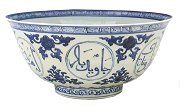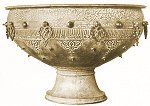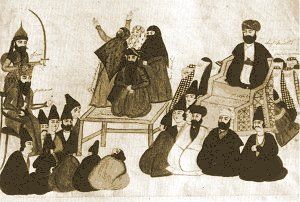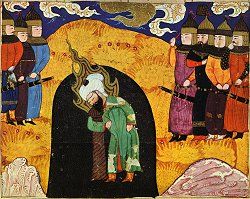Serving the Guest: A Sufi Cookbook
Essays | Recipes | Gallery

When the waters of the great Flood began to recede, the Prophet Noah (peace and blessings upon him) and his family are said to have gathered up all of the food remaining on the Ark and transformed it into a delicious pudding. The Ark eventually came to rest on Mount Ararat, in ancient Armenia, and in remembrance, the Armenian people traditionally prepare Noah's pudding on Christmas. Christian communities throughout the Middle East prepare a similar sweet wheat dish, called hedik, amah or qamhiyyi, in celebration of a baby's first tooth. Throughout Anatolia as recently as the 17th century CE, the pudding was served at special Friday evening gatherings and during the month of Ramadan. Over time it came to be associated with and adopted the name of the Feast of Ashura, a day with multifaceted significance.
For centuries the Jewish people have observed Yom Kippur, the Day of Atonement, with fasting and ritual. According to hadith, the tradition of the Jews of the time of Muhammad (peace and blessings upon him) was that on this day, the 10th of Tishri, God delivered Moses and his people and drowned Pharaoh and his forces; so Moses (peace and blessings upon him) observed it as a fast out of gratitude. This date has also been commemorated as the anniversary of the creation of Adam and Eve, life and death, heaven and hell, the Pen and the Tablet; the deliverance of Abraham (peace and blessings upon him) from the fire; and the reuniting of Jacob and Joseph.
In the early days of the Qur'anic revelation, Muhammad ordered that the corresponding date in the Muslim calendar — the 10th of Muharram, known as Ashura (Arabic for "tenth") — be observed by Muslims with a day-long fast. Although it was eventually superceded by the month-long fast of Ramadan, the Prophet continued to fast on Ashura, and recommended that Muslims do so, saying "I seek from God that fasting on the day of Ashura may atone for the sins of the preceding year."
About sixty years later, on the 10th of Muharram AH 61 (10 October 680 CE), the efforts of the Caliph Yazid of Damascus to consolidate his authority culminated in the murder of Huseyn — son of Ali, grandson of the Prophet, and the Third Imam — with his infant son, eighteen men of his family and fifty-four male companions, and the capture of their wives and children on the plain of Kerbala. This battle is widely regarded as the signal event in the history of Islam after the death of the Prophet, and in Shi'i communities is commemorated with dramatic, emotional mourning rituals known as taziye. In this context, preparation and distribution of ashura serves as a reminder of the last meal of these descendants of the Prophet, and as recompense for the fact that they were allowed to die while they were hungry and thirsty. This primary association is shared by many Sufi orders, for Huseyn's father Ali was the Prophet's closest companion, the person to whom Sufis attribute the revelation of mystic understanding of the Qur'an, and the first person after Muhammad in the silsila (spiritual genealogy) of most Sufi orders.
The 17th century traveler Evliya Efendi took note of the Ashura rituals that took place during his visit to Tabriz:
In remembrance of some or all of the events related to this day, people throughout the Muslim world fast (either after the example of the Prophet, or in remembrance of the suffering of the martyrs), mourn, and prepare special food in large quantities to share with their families, communities, and, indeed, any person who happens to catch its fragrance. Sharing food — all partaking of one sweet substance out of the same pot — offers a way to reaffirm unity and the essential relationship of humans to one another, and to their Creator.
The customs of mourning and preparing special food on the 10th of Muharram are found from Indonesia to the Caribbean; in each region those customs have assumed a unique local color. According to Indonesian legend, Hasan and Huseyn wanted to give a feast for their grandfather, the Prophet, when he was in the midst of battle. They brought rice to the river to wash it, but the enemy's horses kicked it into the river. The two boys cried, but picked up the rice and made porridge of it anyway — sand, pebbles and all. When the Indonesian Ashura feast is given (though rarely), two batches of porridge are prepared, one with pebbles and sand for the grandsons to eat, and another with peanuts and fried cassava, for everyone else.
The communal Ashula meal prepared by the Hui Muslims of China had its legendary origins on the third day of a battle, when Ali and his soldiers had run out of food. When the commander's sons Hasai and Hasan could find no food despite great effort, they and Fatima resorted to filling a cauldron of boiling water with stones and sawdust. This unappetizing mixture was miraculously transformed into a porridge of millet, rice, wheat, and barley; hyacinth beans, mung and soy beans, peas, dates, walnuts, and other delicacies — and though there appeared to be only a modest amount of the porridge, all of the soldiers ate until they were full.
In Malaya, Ashura is said to have been the day when the impoverished Muhammad threw every edible scrap he could find into a large pot. The occasion is commemorated with a village-wide celebration in which everyone contributes firewood, utensils and food.

In the morning, great kettles are placed in freshly-dug holes in the ground. Rice, sweet potatoes, yams, coconuts, pumpkin, corn, onions, peanuts, and even meat — any foods available — are cooked and constantly stirred for hours. At the end of the cooking, coconut cream, spices and palm sugar are added. When all is ready, children are given small portions to eat on the spot; and every adult villager brings home a dish full of thick, glutinous, dark, sweet, spicy, nutty pudding.
In Morocco, Ashura is mainly observed by women and children. In the Maghrib, the practice of mourning the death of an old year and celebrating the birth of the new year predated Islam; the extension of the practice into an Islamic context likely began in Shi'i communities that existed there between the 9th-12th centuries, and was perpetuated by the Sherifs, the descendants of the Prophet. Though the custom of mourning persists, it no longer has a specific focus. For the occasion, women make special raisin and nut sweets called krishlat, couscous made with the preserved tail of a sacrificial ram, and special fritters, flat cakes and porridges, eggs and poultry dishes.
In 20th century Iran, shollezard is the dish now commonly prepared during Muharram. In Pakistan on Ashura, many households, whether in mourning or not, prepare sweet pilaf or semolina halvah, which is then blessed and distributed to guests and to the community. In the Caribbean, and especially in Trinidad, citizens of Indian descent observe the 10th of Muharram with the ritual called Hosay. Over the one hundred fifty years since its introduction to the Caribbean, Hosay has come to be celebrated by Muslims and Hindus alike as an affirmation of cultural identity. Elaborate processions move through the streets, with colorful models of mosques borne on carts, followed by female mourners singing dirges for Huseyn. As in Pakistan and India, sweet dishes are blessed and shared. In Jamaica, participants in the Friday evening taziyeh parade are offered malida, a fried blend of burnt sugar, flour and molasses — a Caribbean version of halvah.

The number of ingredients in the ashura pudding prepared in Anatolia and the Balkans varies from recipe to recipe. One tradition calls for forty ingredients, one for each day of the Flood.
They always include dried fruits and nuts, legumes, grains and sweetener (traditionally the grape syrup pekmez, but now more commonly sugar). This "Ark pantry food" is gathered from many households and brought together in an enormous pot, called in Turkish the kazan. Milk is called for in some recipes, but is not used when the quantity requires that the ashura be cooked for many hours. In Tirana, Albania, for instance, enough ashura is made to feed 600 people.
The Bektashi Order's preparation of ashura is an expression of their special reverence for the twelve Imams. Bektashi dervishes spend several days accumulating the ingredients, and hymns to Husayn accompany the stirring of the kazan. Every year in Tirana, the kazan is fetched from the Albanian National Ethnographic Museum and restored to its place of honor on the tekke hearth. It is used to prepare the ashura, and at the end of Muharram is scrubbed clean and returned to the museum. After the first tremendous batch of ashura has been distributed, members of the Bektashi community take turns preparing more ashura at home and bringing it to the tekke to be shared.
The granddaughter of a Bektashi Shaikh remembers her childhood in the Istanbul tekke:
Some time after the death of Mevlana Jalaluddin Rumi, similar rituals evolved among the Mevlevis. Their practice includes stirring the ashura in the form of the double waw. Literally, the figure represents the Arabic conjunction "and," and has been called "the letter of connection between man and God," and is also known as "the ear of the Prophet." Most importantly to the Mevlevis, it is the calligraphic form of the divine pronoun Hu, "the essential part of the divine name, which automatically accompanies every breath we take." By stirring the ashura in the form of Hu, and consciously sounding Hu into the pot, the preparation of a pudding is transformed into a form of dhikr. Inshallah, by sharing in this way the preparation of ashura, the conscious remembrance of divine essence is carried into the nourishment provided to the body, and magnified within the community of seekers. By sharing the ashura with the greater community, the breath of that conscious remembrance may spread, spoonful by spoonful, out into the world.

from Serving the Guest: A Sufi Cookbook
Copyright © 1999, 2000 by Kathleen Seidel
Sources of previously published material by other authors used by permission, and print sources for images, may be found at http://www.superluminal.com/cookbook.

